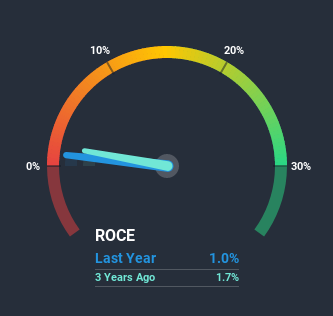Sutton Harbour Group (LON:SUH) Could Be Struggling To Allocate Capital
What underlying fundamental trends can indicate that a company might be in decline? Businesses in decline often have two underlying trends, firstly, a declining return on capital employed (ROCE) and a declining base of capital employed. Basically the company is earning less on its investments and it is also reducing its total assets. In light of that, from a first glance at Sutton Harbour Group (LON:SUH), we've spotted some signs that it could be struggling, so let's investigate.
Understanding Return On Capital Employed (ROCE)
Just to clarify if you're unsure, ROCE is a metric for evaluating how much pre-tax income (in percentage terms) a company earns on the capital invested in its business. The formula for this calculation on Sutton Harbour Group is:
Return on Capital Employed = Earnings Before Interest and Tax (EBIT) ÷ (Total Assets - Current Liabilities)
0.01 = UK£748k ÷ (UK£75m - UK£2.2m) (Based on the trailing twelve months to September 2020).
So, Sutton Harbour Group has an ROCE of 1.0%. Ultimately, that's a low return and it under-performs the Infrastructure industry average of 7.1%.
See our latest analysis for Sutton Harbour Group
Historical performance is a great place to start when researching a stock so above you can see the gauge for Sutton Harbour Group's ROCE against it's prior returns. If you want to delve into the historical earnings, revenue and cash flow of Sutton Harbour Group, check out these free graphs here.
What Does the ROCE Trend For Sutton Harbour Group Tell Us?
We are a bit worried about the trend of returns on capital at Sutton Harbour Group. About five years ago, returns on capital were 2.1%, however they're now substantially lower than that as we saw above. And on the capital employed front, the business is utilizing roughly the same amount of capital as it was back then. This combination can be indicative of a mature business that still has areas to deploy capital, but the returns received aren't as high due potentially to new competition or smaller margins. So because these trends aren't typically conducive to creating a multi-bagger, we wouldn't hold our breath on Sutton Harbour Group becoming one if things continue as they have.
The Bottom Line
In the end, the trend of lower returns on the same amount of capital isn't typically an indication that we're looking at a growth stock. Long term shareholders who've owned the stock over the last five years have experienced a 16% depreciation in their investment, so it appears the market might not like these trends either. That being the case, unless the underlying trends revert to a more positive trajectory, we'd consider looking elsewhere.
On a final note, we found 3 warning signs for Sutton Harbour Group (2 are a bit concerning) you should be aware of.
If you want to search for solid companies with great earnings, check out this free list of companies with good balance sheets and impressive returns on equity.
This article by Simply Wall St is general in nature. It does not constitute a recommendation to buy or sell any stock, and does not take account of your objectives, or your financial situation. We aim to bring you long-term focused analysis driven by fundamental data. Note that our analysis may not factor in the latest price-sensitive company announcements or qualitative material. Simply Wall St has no position in any stocks mentioned.
Have feedback on this article? Concerned about the content? Get in touch with us directly. Alternatively, email editorial-team (at) simplywallst.com.

